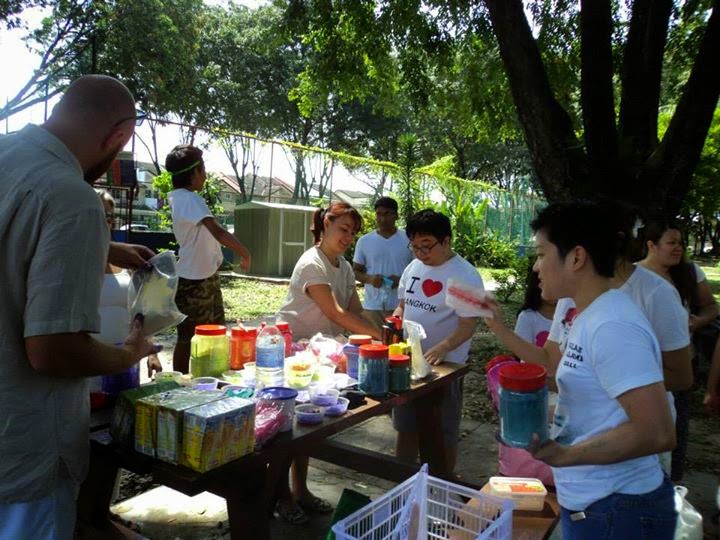This year is my 14th as a Malaysian Nature Society Raptor Watch Volunteer.
Due to some issues with the state governments of Melaka and Negeri Sembilan, Raptor Watch was truncated into a one-day event for the first time ever this year.
There were highs and lows to this. The highs were that transport was provided, and so there were fewer cars on the road that weekend. Also, it freed up time for us to do other things apart from volunteering with the MNS that weekend.
The lows included the fact that one day is simply too little time for us to do conservation outreach and nature appreciation. Not having the event in Ilham Resort this year also meant that lunch had to be packed in plastic recyclable containers and delivered to us -- we didn't get a low-waste sit-down buffet the way we are used to. Having to set up and man our booths in the Tanjung Tuan Forest Reserve meant that we were more exposed to mosquitoes.
However, it was cooler in the shade of the trees than in the hot event grounds of Ilham Resort, and I had the opportunity to take a break to explore the beach on the other side of the forest reserve.
Crowds thronging the Tg. Tuan Forest Reserve. Our booths and stalls were strategically placed along the paved jungle trail all the way up to the Lighthouse.
Green Living's booth was next to the Malaysian Conservation Alliance for Tigers' (MYCAT). They had a little challenge of some sort going on.
Our diligent young volunteer Zhang En explaining the rules of her sister's Pinwheel Game to a visitor at our booth. Her little sister and mother could not volunteer this year due to a prior engagement, and I missed having them around.
Zhang En takes a break to climb up a pole.
As all children should.
Aravind and Zhang En manning the Green Living booth and explaining the rules of the games and conservation issues to the visitors.
Groups of young visitors from local schools and colleges visited our booth and played our conservation-related Carnival games.
I had the opportunity to take an hour off to go on a nature walk on my own when I saw that my experienced volunteers were running the booth rather smoothly and competently. Everyone was able to take turns to go off on walks of their own. I walked along the trail with my trusty rubbish claw and rubbish bags and picked up litter along the way.
Visiting my friends Ilyas and Sumitra at the Nature Guides booth, where they were busy registering participants for the Jungle Walks and conducting the walks.
I picked up a large Macaranga leaf from the forest floor and used it to shade my head from the heat.
A pretty wild-looking Pandanus plant.
Booths at the foot of the steps to the Cape Rachado Lighthouse.
The MNS booth, manned by the Secretariat and the Science and Conservation Officers.
The MNS Selangor Bird Group registering participants for the upcoming My Garden Birdwatch.
Handmade plushies of the MY Garden Birdwatch mascot! Isn't this simply darling?
To make up for the fact that this year's Raptor Watch is just a one-day affair, the Melaka State Government actually gave visitors access to the lighthouse compound, which is otherwise a high security area off-limits to the public.
I explored the trail to the left of the lighthouse. I knew it leads to the beach, but I have never been there and did not know how long the trek would be.
The beach was secluded and highly beautiful. I could scarcely believe that this is a beach in Malaysia. What? No Ramly Burger stands, Family Day excursions, tonnes of litter, irresponsible and messy picnickers and balloons and styrofoam everywhere? How could this be!?!
I spotted what I had initially believed to be fossilised marine molluscs of some sort on some of the rocks on the beach. I was pretty excited to see this because digging up a real fossil has been on my Mighty Life List for ages.
I learned later that they were a kind of barnacle, and not ancient or uncommon at all.
Phooey.
This was the absolute best moment of the day for me. Two teenagers, unbidden, went from booth to booth, collecting rubbish and picking up litter from the ground. I could have cried. I've been doing this alone for so long that I am gratified to see anyone who is not ashamed to pick up litter from places of natural and environmental interest. Good job and thank you, guys!
Lillian came over with her son Tristan and they played some of the games at the Green Living booth, including the 3R Target Shooting Game. I forgot to borrow CovertTwin's Nerf gun before the event, so I had to make do with pop guns from Daiso instead. The guns worked a treat, though.
May each Raptor Watch be better than the last.
CovertOps78, OUT.
May each Raptor Watch be better than the last.
CovertOps78, OUT.

































































